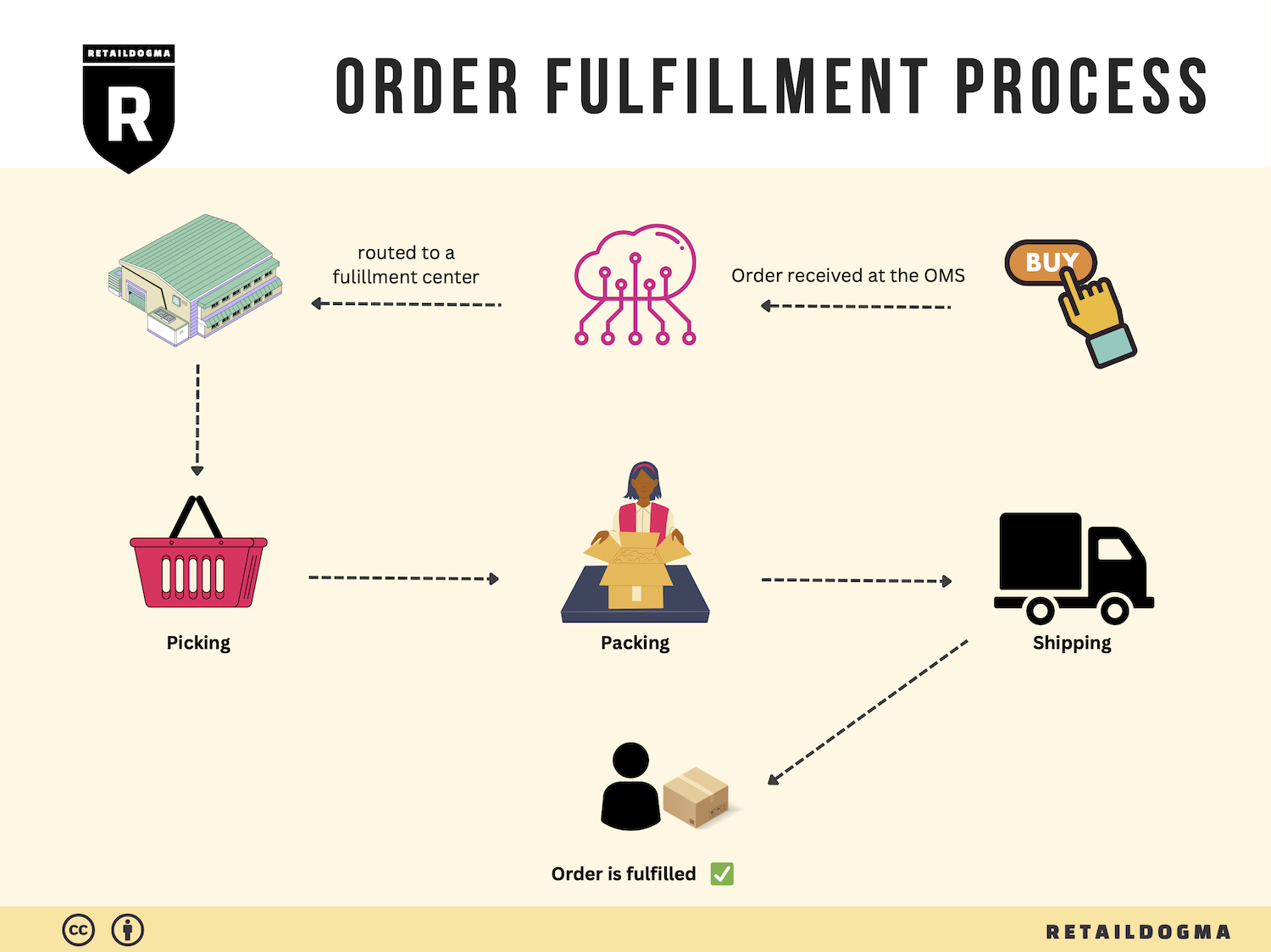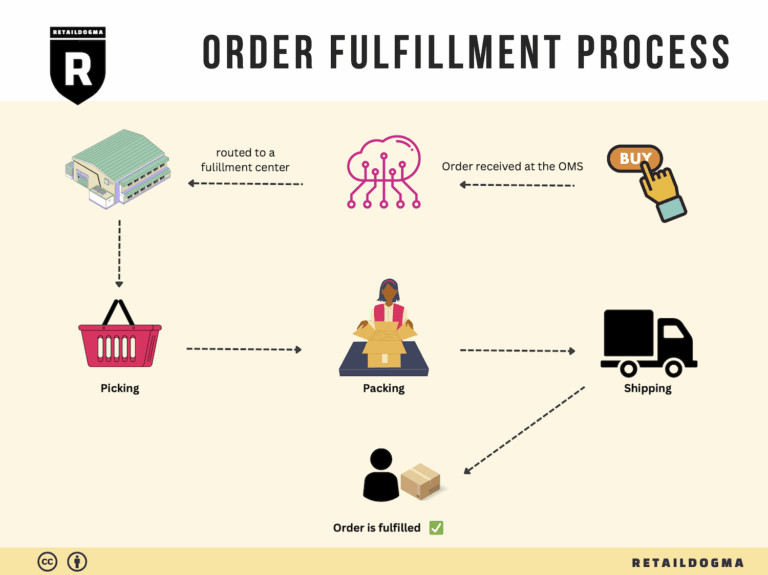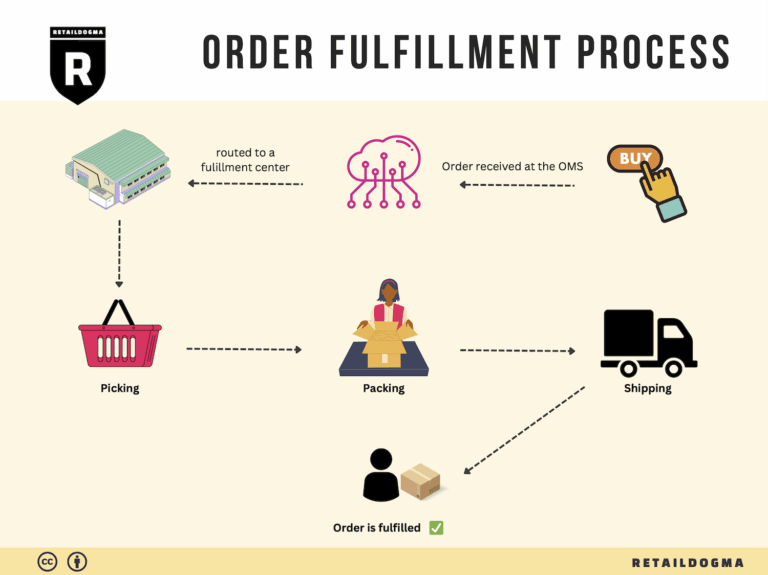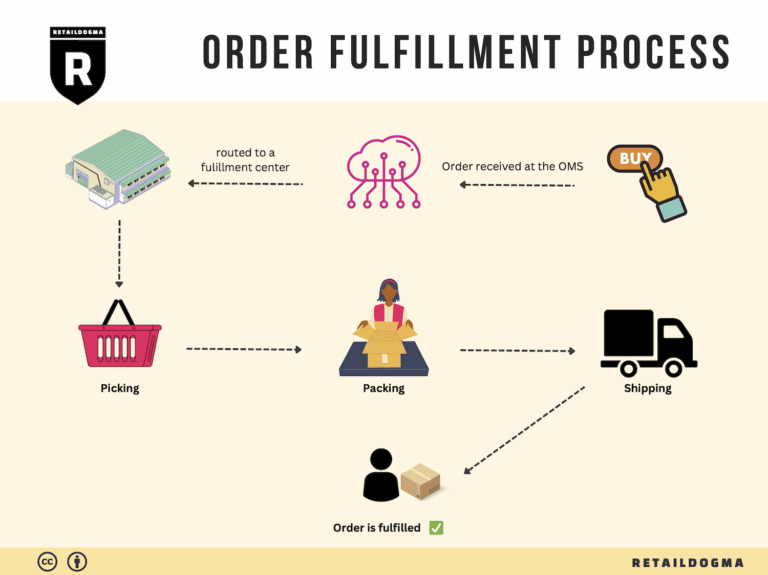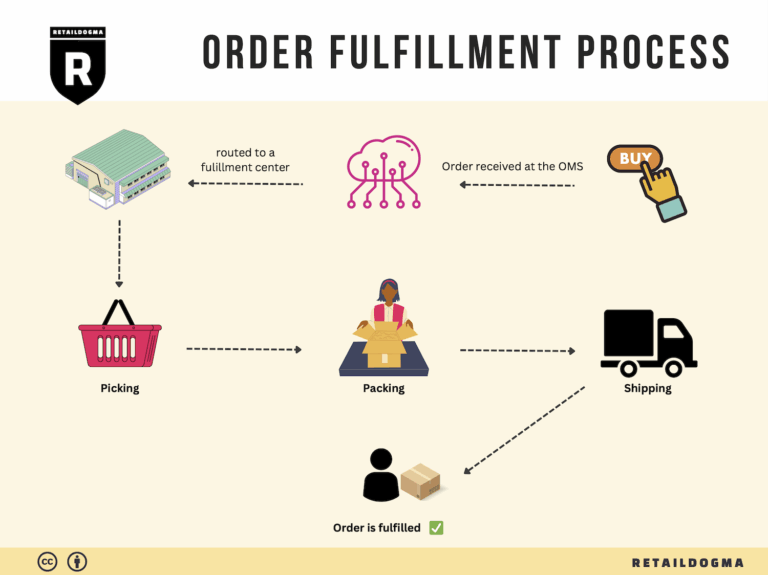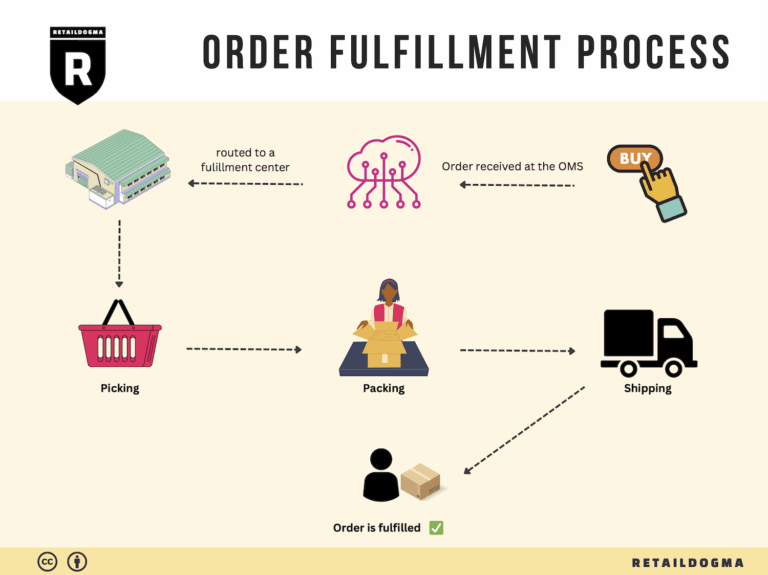How Order Fulfillment Works: A Step-by-Step Guide for Businesses
What is E-commerce Fulfillment? An Introduction for Growing Businesses
Growing an online business can be both exhilarating and overwhelming, especially when it comes to managing the logistics of packing and shipping orders. As your sales increase, so do the complexities of fulfilling those orders efficiently and accurately. Many e-commerce entrepreneurs find themselves bogged down by the day-to-day operations of packing boxes, printing shipping labels, and handling returns, all of which can detract from focusing on what truly matters: scaling your business.
At its core, e-commerce fulfillment is the process of getting a product from your inventory to the customer’s doorstep. This includes everything from receiving inventory and storing it, to picking, packing, and shipping orders, as well as managing returns. As customer expectations for fast and reliable delivery continue to rise, understanding the nuances of fulfillment becomes essential for any growing business.
This guide will explore the various fulfillment models available to online retailers, such as third-party logistics (3PL) providers and Fulfillment by Amazon (FBA). Each model comes with its own set of advantages and challenges, which we will break down to help you determine the best fit for your operations. We will also discuss the core services that fulfillment partners offer, including inventory management, order processing, and customer service, so you can select a partner that aligns with your business goals.
Choosing the right fulfillment partner is critical to your success. This guide will outline key considerations, such as the scalability of services, geographical coverage, technology integration, and the expertise of the fulfillment staff. We’ll also provide insights on pricing structures, enabling you to understand the potential costs involved and how to budget effectively.
Ultimately, the goal of this guide is to empower your business with the knowledge needed to make informed decisions about your logistics strategy. By understanding the options available and the factors that influence fulfillment, you can streamline operations, enhance customer satisfaction, and focus on growing your e-commerce business. Let’s dive in and discover how efficient fulfillment can transform your logistics into a competitive advantage.
What You’ll Learn In This Guide
- What is E-commerce Fulfillment? An Introduction for Growing Businesses
- The Order Fulfillment Process: From ‘Buy’ Button to Customer’s Door
- Comparing Fulfillment Models: In-House vs. 3PL vs. Dropshipping
- A Deep Dive into Amazon FBA: Pros, Cons, and Who It’s For
- Core Services Offered by Fulfillment Centers
- How to Choose a Fulfillment Partner: A 6-Point Checklist
- Understanding Fulfillment Pricing: A Breakdown of Common Fees
- Frequently Asked Questions (FAQs) about Fulfillment
- Conclusion: Is Outsourcing Fulfillment the Right Move for Your Business?
- Important Disclaimer
The Order Fulfillment Process: From ‘Buy’ Button to Customer’s Door
1. Receiving Inventory
The first step in the order fulfillment process is receiving inventory. This stage involves the acceptance of products from suppliers or manufacturers at a fulfillment center. Upon arrival, inventory items are checked against purchase orders to verify quantity and condition, which is crucial for ensuring accuracy and maintaining quality standards. A key term associated with this step is SKU (Stock Keeping Unit), which is a unique identifier for each product that facilitates tracking and inventory management.
Why is this important? Proper receiving processes help prevent stock discrepancies, reduce losses, and ensure that the right products are available for order fulfillment. Additionally, efficient receiving can lead to quicker turnaround times, ultimately enhancing customer satisfaction. Leveraging technology such as barcode scanning and inventory management systems can streamline this process, making it more efficient and accurate.
2. Warehouse Storage
Once the inventory is received and verified, it moves to the warehouse storage phase. In this step, products are organized and stored in designated locations within the fulfillment center. Effective warehouse storage strategies involve categorizing products based on various factors like size, demand, and shipping frequency. A common key term here is ABC analysis, which categorizes inventory into three groups (A, B, and C) based on their importance and sales volume.
The significance of this step lies in optimizing space utilization and facilitating easier access to items. Properly organized storage not only enhances operational efficiency but also reduces the time taken to pick orders later in the process. Businesses should consider investing in advanced Warehouse Management Systems (WMS) to track inventory levels, monitor storage conditions, and streamline the retrieval process.
3. Order Picking
Order picking is the process of retrieving items from warehouse storage to fulfill customer orders. This step is crucial because it directly impacts the accuracy and speed of order fulfillment. A key term in this phase is pick lists, which are documents that outline the items and quantities needed for each order. These lists guide fulfillment associates in efficiently locating and collecting products.
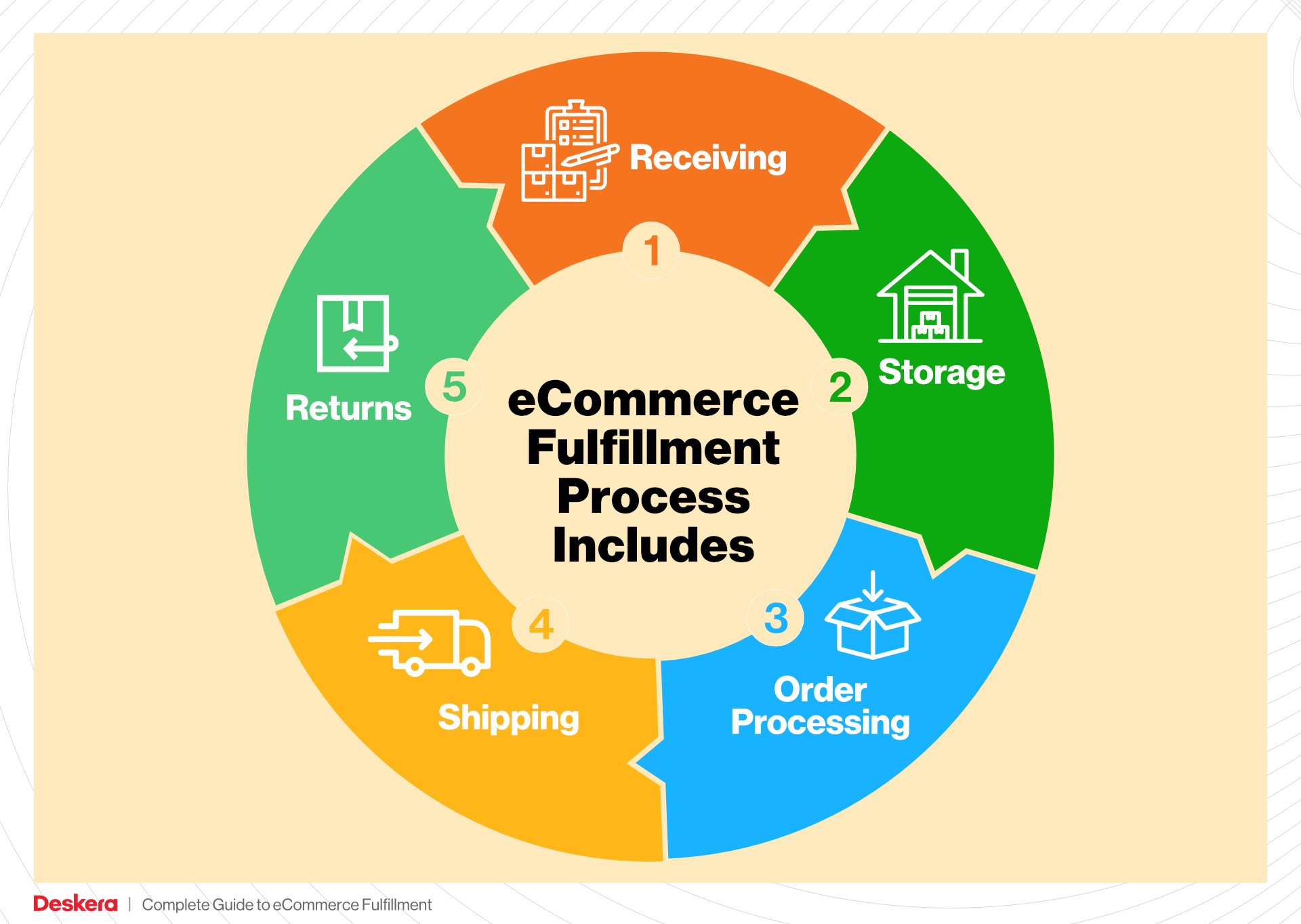
Efficient order picking is vital for meeting customer expectations, especially in an era where rapid delivery is the norm. Businesses can implement various picking strategies such as single order picking, batch picking, or zone picking, depending on their volume and operational capacity. Automation technologies, including robotic picking systems, can also enhance picking efficiency, reduce labor costs, and minimize human error.
4. Order Packing
After items are picked, they move to the order packing stage. This involves securely packaging the products for shipment, ensuring they are protected during transit. Key considerations during this step include selecting the right packaging materials and optimizing box sizes to reduce shipping costs. A term to note here is dimensional weight pricing, which refers to the pricing of shipping based on the dimensions of the package rather than just its weight.
The packing process is crucial because it affects not only the safety of the products during delivery but also the overall customer experience. Well-packed orders can reduce return rates and increase customer satisfaction. Businesses should train packing staff on best practices and consider investing in packing automation solutions to enhance efficiency and accuracy.
5. Shipping & Delivery
The final step in the order fulfillment process is shipping and delivery. Once packages are packed, they are labeled and handed over to shipping carriers for transportation to the customer’s address. A key term in this phase is last-mile delivery, which refers to the final leg of the delivery journey from a distribution center to the end consumer.
The importance of this step cannot be overstated, as it ultimately determines how quickly and efficiently customers receive their orders. Businesses must choose reliable shipping partners and consider various shipping options to meet customer expectations for speed and cost-effectiveness. Implementing tracking systems that allow customers to monitor their order status can also enhance transparency and improve the overall shopping experience.
In conclusion, understanding and optimizing each step of the order fulfillment process is essential for e-commerce businesses aiming to scale operations and meet customer demands effectively. By focusing on efficient inventory management, organized warehouse storage, accurate order picking, secure packing, and reliable shipping, businesses can improve their fulfillment strategy and enhance customer satisfaction.
Comparing Fulfillment Models: In-House vs. 3PL vs. Dropshipping
Fulfillment Model Comparison Table
| Model | Who Handles Inventory | Best For (Business Stage) | Key Advantage | Key Disadvantage |
|---|---|---|---|---|
| In-House Fulfillment | The business itself | Startups to established firms | Complete control over inventory and processes | High overhead costs and resource demands |
| Third-Party Logistics (3PL) | An external logistics provider | Growing and scaling businesses | Scalability and reduced operational burden | Less control over inventory and fulfillment speed |
| Dropshipping | Suppliers or manufacturers | New entrepreneurs or niche markets | Low startup costs and minimal risk | Lower profit margins and reliance on suppliers |
In-House Fulfillment
In-house fulfillment is a model where the e-commerce business manages its own inventory, storage, and shipping operations. This approach allows for complete control over the entire fulfillment process, from warehousing to order processing and shipping. Companies that choose this model typically invest in their own warehouse or distribution center, hire staff for order picking and packing, and implement their own inventory management systems.
This model is best suited for businesses that have reached a stable operational stage and can afford the upfront investment in infrastructure and personnel. The key advantage of in-house fulfillment is the ability to maintain direct oversight of inventory and customer service. Businesses can tailor their processes to meet specific customer demands and preferences, ensuring a consistent brand experience. However, this comes with significant disadvantages, including high overhead costs for warehousing and staffing, as well as the complexity of managing logistics, which can divert focus from core business activities such as product development and marketing.
Third-Party Logistics (3PL)
Third-party logistics (3PL) involves outsourcing fulfillment operations to an external provider specializing in logistics services. A 3PL company manages inventory, warehousing, order processing, and shipping on behalf of its clients. This model is particularly advantageous for growing businesses that need to scale their operations quickly without the significant capital investment required for in-house fulfillment.
One of the key advantages of 3PL is scalability; businesses can adjust their logistics needs based on demand fluctuations without having to manage the complexities of warehousing and distribution. Additionally, 3PL providers often have established relationships with shipping carriers, which can lead to reduced shipping costs and improved delivery times. However, the primary disadvantage is a loss of control over inventory and fulfillment processes. This can lead to potential issues with order accuracy, delays, and customer service, as businesses must rely on their logistics partner to uphold their standards.
Dropshipping
Dropshipping is a fulfillment model where the business does not hold inventory but instead relies on suppliers or manufacturers to fulfill customer orders directly. When a customer places an order, the business forwards the order details to the supplier, who then ships the product directly to the customer. This model is particularly appealing for new entrepreneurs or those looking to enter niche markets with minimal upfront investment.
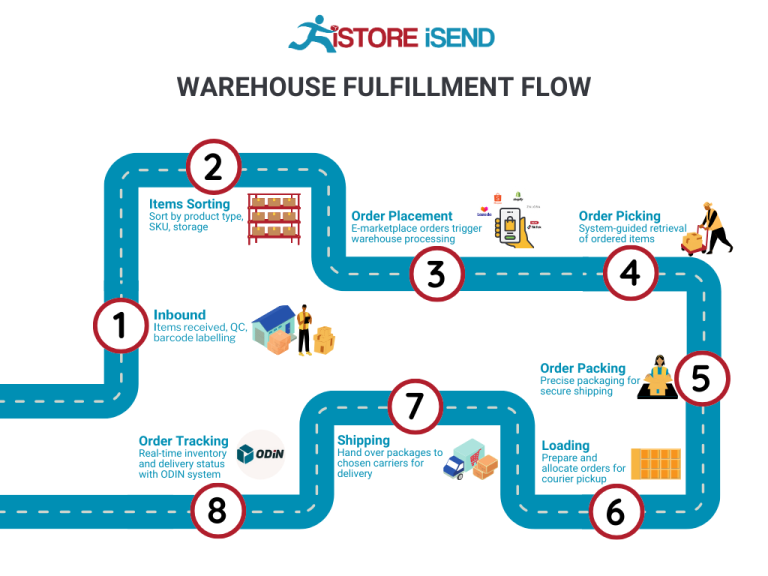
The main advantage of dropshipping is the low startup costs, as there is no need to invest in inventory or warehousing. This model allows entrepreneurs to test new products and markets without significant financial risk, making it ideal for those just starting. However, dropshipping has notable disadvantages, including lower profit margins due to reliance on suppliers and the potential for stockouts or delays beyond the business’s control. Additionally, the lack of control over inventory and shipping can lead to inconsistencies in customer experience, which can harm the brand’s reputation.
Conclusion
Choosing the right fulfillment model is critical for e-commerce businesses looking to scale effectively. Each model—In-House Fulfillment, Third-Party Logistics, and Dropshipping—offers unique advantages and disadvantages that can significantly impact operational efficiency, customer satisfaction, and overall profitability. Business owners must carefully assess their current stage, resources, and long-term goals to determine the most suitable fulfillment strategy. By aligning the chosen model with their operational capabilities and market demands, e-commerce businesses can optimize their logistics and enhance their growth potential.
A Deep Dive into Amazon FBA: Pros, Cons, and Who It’s For
Understanding Fulfillment by Amazon (FBA)
Fulfillment by Amazon (FBA) is a logistics service offered by Amazon that allows e-commerce sellers to store their products in Amazon’s fulfillment centers. With FBA, Amazon takes on the responsibility of storage, packaging, and shipping of products directly to customers. This service has transformed the way many businesses operate, enabling them to leverage Amazon’s extensive logistics network to enhance their customer service and operational efficiency.
How FBA Works
-
Product Listing and Storage: Sellers create product listings on Amazon and send their inventory to Amazon’s fulfillment centers. Once the products arrive, they are stored in Amazon’s warehouses, where they are managed and organized.
-
Order Processing: When a customer places an order for a product listed as FBA, Amazon takes over the order processing. This includes picking the product from the shelf, packing it securely, and shipping it to the customer.
-
Customer Service and Returns: Amazon handles customer service inquiries related to FBA orders, including returns and refunds. This alleviates the burden on sellers, allowing them to focus on other aspects of their business.
-
Multi-Channel Fulfillment: In addition to fulfilling orders from Amazon’s marketplace, sellers can use FBA to fulfill orders from their own websites or other sales channels, thereby streamlining their logistics operations.
Pros of Using Amazon FBA
1. Prime Eligibility
One of the most significant advantages of using FBA is that products become eligible for Amazon Prime. This increases visibility and attractiveness to Prime members, who prioritize fast shipping options. As a result, sellers often experience higher sales volumes.
2. Customer Trust
Products fulfilled by Amazon benefit from the trust and reliability associated with the Amazon brand. Customers are more likely to purchase items that are backed by Amazon’s customer service and return policies, leading to increased conversion rates for FBA sellers.
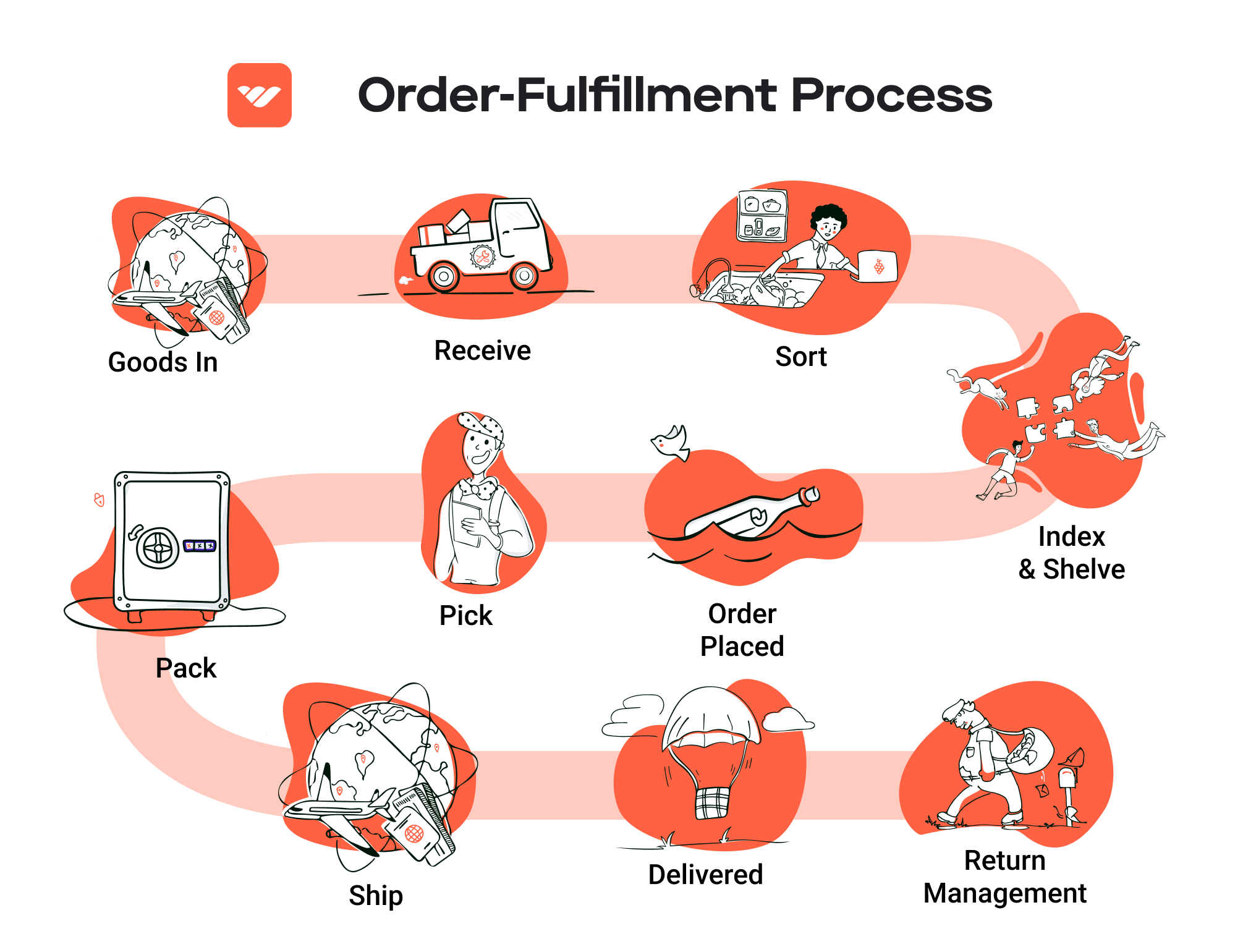
3. Multi-Channel Fulfillment
FBA allows sellers to fulfill orders from multiple sales channels. This means that whether a customer orders from Amazon, the seller’s own website, or another marketplace, Amazon can handle the logistics. This flexibility is particularly beneficial for businesses looking to scale and reach a broader audience.
4. Streamlined Logistics
With FBA, sellers can offload complex logistics tasks, such as inventory management, packing, and shipping, to Amazon. This allows them to focus on product development, marketing, and other core business activities, potentially leading to improved overall efficiency.
5. Advanced Shipping Options
FBA offers access to Amazon’s sophisticated logistics network, which includes advanced shipping options like same-day or two-day delivery. This can significantly enhance customer satisfaction and loyalty.
Cons of Using Amazon FBA
1. High Fees
While FBA provides numerous benefits, it comes with a price. Amazon charges various fees, including storage fees for inventory stored in fulfillment centers and fulfillment fees based on the size and weight of products. These costs can add up, particularly for sellers with low-margin products.
2. Strict Inventory Rules
Sellers must adhere to Amazon’s strict inventory guidelines, which include requirements for labeling, packaging, and storage. Non-compliance can result in additional fees or, worse, having inventory returned or destroyed. This can be particularly challenging for new sellers who are still learning the ropes.
3. Commingling Risks
When using FBA, sellers’ inventory may be commingled with that of other sellers. This can lead to potential issues, such as receiving returns for products that were not originally sold by the seller. In some cases, this can also result in negative customer experiences that reflect poorly on the seller.
4. Limited Control Over Fulfillment
By outsourcing fulfillment to Amazon, sellers relinquish some control over the packaging and shipping process. This can be concerning for businesses that have specific branding requirements or wish to provide a unique customer experience through customized packaging.
5. Inventory Management Challenges
Managing inventory effectively can be more complicated with FBA. Sellers must regularly monitor stock levels and ensure they don’t run out of popular items, as this can lead to lost sales and lower rankings on Amazon’s search results.
Who is FBA Best For?
Fulfillment by Amazon is best suited for e-commerce businesses that:
-
Have High Sales Volumes: Businesses that can leverage FBA to manage large volumes of sales will benefit the most from the efficiencies and customer trust that FBA provides.
-
Sell Consumer Products: Products that are in demand and can benefit from Prime eligibility are ideal candidates for FBA.
-
Desire to Scale Quickly: Entrepreneurs looking to rapidly scale their operations can take advantage of Amazon’s logistics without having to invest heavily in their own warehousing and fulfillment infrastructure.
-
Prioritize Customer Service: Businesses that want to provide excellent customer service without the overhead of managing returns and inquiries may find FBA to be a valuable solution.
-
Sell Across Multiple Channels: Sellers who wish to operate on multiple platforms while maintaining a unified fulfillment strategy will find FBA’s multi-channel fulfillment capabilities particularly advantageous.
In conclusion, while Amazon FBA offers a compelling solution for many e-commerce sellers by simplifying logistics and enhancing customer trust, it is essential to weigh the associated costs and operational challenges. By understanding both the pros and cons, business owners can make informed decisions about whether FBA aligns with their growth strategy and operational capabilities.
Core Services Offered by Fulfillment Centers
Inventory Management & Warehousing
Inventory management and warehousing are foundational services provided by fulfillment centers. This involves the systematic tracking, storage, and management of inventory to ensure that products are available when needed. Fulfillment centers use advanced Warehouse Management Systems (WMS) to monitor stock levels, manage replenishment, and track inventory movements in real-time.
Benefits:
– Optimized Stock Levels: By maintaining precise inventory counts, fulfillment centers help prevent stockouts and overstock situations. This is crucial for e-commerce businesses, as running out of popular items can lead to lost sales and dissatisfied customers.
– Reduced Storage Costs: Fulfillment centers typically offer scalable storage solutions that adapt to the seasonal fluctuations in demand. Businesses can store their inventory in a cost-effective manner without the overhead associated with owning warehouse space.
– Improved Order Accuracy: With automated systems for tracking inventory, fulfillment centers significantly reduce human error in order fulfillment. This leads to higher customer satisfaction due to fewer shipping mistakes.
Pick and Pack Services
Pick and pack services are integral to the fulfillment process. This service involves selecting items from inventory (picking) and preparing them for shipment (packing). Fulfillment centers employ efficient picking strategies—like batch picking or wave picking—to expedite this process, ensuring that orders are fulfilled quickly and accurately.
Benefits:
– Speedy Fulfillment: Quick pick-and-pack operations enable e-commerce businesses to meet customer expectations for fast shipping. In a competitive market, the ability to ship orders within 24 hours can be a significant advantage.
– Customized Packaging: Fulfillment centers often offer tailored packing solutions that reflect the branding and requirements of the business. This not only enhances the customer experience but can also reduce shipping costs by optimizing package size and weight.
– Scalability: As businesses grow, their order volumes can fluctuate significantly. Fulfillment centers can efficiently scale pick-and-pack operations to match increased demand, allowing businesses to focus on growth without the need for additional logistical resources.
Kitting and Assembly
Kitting and assembly services involve combining multiple products into a single package or assembling components into a final product. This is particularly beneficial for businesses that sell products that are often bundled together, such as gift sets or promotional items.
Benefits:
– Enhanced Product Offering: By offering kitted products, e-commerce businesses can provide more value to customers and differentiate their offerings in a crowded marketplace. Bundling items can also encourage larger purchases and increase average order value.
– Streamlined Operations: Outsourcing kitting and assembly to fulfillment centers can simplify operations for e-commerce businesses. This allows them to focus on core activities such as marketing and customer service while ensuring that complex orders are handled efficiently.
– Reduced Lead Times: Fulfillment centers with specialized kitting capabilities can reduce the time it takes to prepare orders, which is crucial for meeting tight deadlines, especially during peak shopping seasons.
Returns Management (Reverse Logistics)
Returns management, or reverse logistics, is a critical service provided by fulfillment centers that involves the processing of returned items. Efficient returns management systems handle everything from receiving returned products to restocking inventory or managing defective items.
Benefits:
– Customer Satisfaction: A streamlined returns process enhances customer satisfaction by making it easy for consumers to return unwanted or defective items. This can foster loyalty and repeat business, as customers are more likely to purchase again from a retailer that offers hassle-free returns.
– Cost Efficiency: By managing returns effectively, fulfillment centers can minimize the costs associated with reverse logistics. This includes reducing the time and labor involved in processing returns and ensuring that returned items are quickly assessed and restocked.
– Data Insights: Fulfillment centers often provide analytics and reporting on return trends, which can offer valuable insights into product performance and customer preferences. This information can be used to improve product offerings and reduce return rates over time.
In summary, leveraging the core services offered by fulfillment centers enables e-commerce businesses to optimize their logistics operations, enhance customer satisfaction, and ultimately scale their operations effectively. Each service plays a vital role in creating a seamless fulfillment process that meets the demands of today’s fast-paced e-commerce environment.
How to Choose a Fulfillment Partner: A 6-Point Checklist
Location & Warehouse Network
Importance: The geographical location of your fulfillment partner’s warehouses can significantly impact shipping times and costs. A strategically placed network of warehouses allows for faster delivery to your customers, which is essential in today’s e-commerce landscape where consumers expect rapid service.
Questions to Ask:
– Where are your warehouses located, and how do they align with my target markets?
– Do you have multiple warehouse locations to facilitate quicker delivery?
– What shipping carriers do you partner with, and how does that affect delivery times?
Technology & Integrations
Importance: In an increasingly digital world, the technology used by your fulfillment partner is critical for seamless operations. A robust Warehouse Management System (WMS) can provide real-time inventory tracking, order management, and integration with your e-commerce platforms, ensuring smooth operations and data flow.
Questions to Ask:
– What WMS do you use, and how does it integrate with popular e-commerce platforms like Shopify, WooCommerce, or Amazon?
– Can you provide real-time tracking and reporting on inventory and orders?
– How do you handle data security and customer information privacy?
Specializations (e.g., Cold Storage, Oversized Items)
Importance: Depending on your product range, specific capabilities might be necessary. For instance, if you sell perishable goods, a partner with cold storage facilities is essential. Similarly, if you deal with oversized items, you need a partner experienced in managing such products.
Questions to Ask:
– Do you have specialized facilities for my product type (e.g., cold storage, hazardous materials, oversized items)?
– Can you handle the specific packaging requirements for my products?
– What experience do you have in managing products similar to mine?
Scalability & Capacity
Importance: As your business grows, your fulfillment needs will change. Choosing a partner that can scale with you is crucial for sustained growth. This includes having the capacity to handle peak seasons, such as holidays, without compromising service quality.
Questions to Ask:
– What is your current capacity for handling orders, and how easily can you scale this capacity?
– How do you manage peak season demands, and what contingency plans do you have in place?
– Can you provide case studies or examples of how you’ve successfully scaled with other clients?
Pricing and Contracts
Importance: Understanding the pricing structure and contract terms is vital to avoid hidden costs that can eat into your margins. A transparent pricing model allows for better budgeting and financial planning.
Questions to Ask:
– Can you provide a detailed breakdown of your pricing structure (e.g., storage fees, pick-and-pack fees, shipping costs)?
– Are there any additional fees I should be aware of, such as for returns or special handling?
– What are the terms of the contract, and how flexible are they in terms of scaling up or down?
Customer Support & Reviews
Importance: Exceptional customer support can make a significant difference in your fulfillment experience. Responsive and knowledgeable support teams can help resolve issues quickly, reducing disruptions to your operations. Additionally, checking reviews can provide insight into the partner’s reliability and service quality.
Questions to Ask:
– What support channels do you offer (e.g., phone, email, chat), and what are your average response times?
– Can you provide references or case studies from current or past clients?
– How do you handle disputes or problems with order fulfillment?
Conclusion
Choosing the right fulfillment partner is a critical decision that can affect your business’s efficiency, customer satisfaction, and ultimately your bottom line. By using this checklist, you can systematically evaluate potential partners and ensure that they align with your operational needs and growth objectives. Take the time to ask the right questions and consider how each potential partner’s offerings will fit into your overall business strategy.
Understanding Fulfillment Pricing: A Breakdown of Common Fees
Initial Setup Fees
Initial setup fees are one-time costs associated with onboarding a new seller or business into a fulfillment center’s system. These fees can include costs for integrating your e-commerce platform with the fulfillment provider’s system, setting up inventory management protocols, and establishing account management features.
The calculation of initial setup fees can vary significantly among providers and may depend on the complexity of the integration. For instance, if you require advanced features such as custom API integrations or specialized inventory tracking capabilities, the costs may increase. It’s essential to obtain a detailed breakdown of these fees to understand what services are included and whether there are any ongoing maintenance charges.
Receiving Fees
Receiving fees are charged when your products are delivered to the fulfillment center. This fee covers the labor and resources required to unload, inspect, and catalog your inventory.
Typically calculated on a per-unit basis, receiving fees can also depend on the size and weight of the products. For example, larger or bulkier items may incur higher receiving fees compared to smaller items. Additionally, if your products require special handling or inspection, these costs could also escalate. Understanding how these fees are structured can help you budget more effectively and select the right fulfillment partner based on your product profiles.
Storage Fees (per pallet/bin)
Storage fees apply to the space your inventory occupies within the fulfillment center. These fees are generally calculated on a monthly basis and can be based on the number of pallets or bins used for storage.
For instance, fulfillment centers may charge a standard monthly fee per pallet, with additional costs for items that require special storage conditions (like climate control). It’s important to monitor your inventory turnover rates; slow-moving items may lead to higher storage fees over time. Many fulfillment centers also offer tiered pricing structures, which means that the more inventory you store, the lower the per-pallet cost may become. This scalability can be beneficial for businesses looking to grow.
Pick & Pack Fees (per item/order)
Pick and pack fees are charged for the process of selecting (or “picking”) items from storage and preparing them for shipment (or “packing”). This fee is typically calculated per item or order, depending on the fulfillment center’s pricing model.
The complexity of your orders can affect pick and pack fees. For example, if your orders often contain multiple items or require specialized packaging, you may incur higher fees. Some fulfillment centers offer discounts for higher volumes, so if you anticipate significant order quantities, it may be worth negotiating for a more favorable rate. Additionally, understanding the specific processes of the fulfillment provider can help you optimize your operations and potentially reduce these fees.
Shipping Fees
Shipping fees are the costs associated with delivering orders to your customers. These fees can vary based on several factors, including the shipping method chosen (standard, expedited, etc.), the destination, the size and weight of the package, and the carrier used.
Fulfillment centers often negotiate shipping rates with carriers and may pass some of these savings on to you. However, it’s crucial to review how these fees are calculated to ensure you are getting the best possible rates. Some fulfillment centers offer flat-rate shipping options, while others may charge based on the dimensions and weight of each package. Understanding your shipping needs and the fulfillment center’s capabilities can help you select the most cost-effective shipping solutions.
Tips for Getting an Accurate Quote
-
Provide Detailed Information: When requesting a quote, provide comprehensive details about your inventory, including dimensions, weights, and any special handling requirements. This information allows fulfillment providers to give you a more accurate estimate.
-
Ask for a Breakdown: Request a detailed breakdown of all fees, including any potential additional costs, to avoid surprises later. Understanding each component of the pricing will help you make informed decisions.
-
Negotiate Terms: Don’t hesitate to negotiate terms, especially if you anticipate high volumes. Many providers are willing to offer discounts or flexible arrangements for long-term partnerships.
-
Consider Long-Term Costs: Evaluate not just the initial setup costs but also the ongoing fees. A lower initial fee might not be beneficial if ongoing costs are high.
-
Compare Multiple Providers: Get quotes from several fulfillment centers to compare pricing structures and services offered. This allows you to find the best fit for your business needs.
By understanding these common fulfillment pricing models and how they are calculated, you can make more informed decisions that align with your business goals and budget.
Frequently Asked Questions (FAQs) about Fulfillment
1. What is the Amazon Fulfillment Center DAS7?
The Amazon Fulfillment Center DAS7 is a specific facility within Amazon’s extensive logistics network. It is designed to process and ship orders directly to customers, ensuring quick delivery times. DAS7 utilizes advanced technology and operational efficiencies to manage inventory and fulfill customer orders effectively.
2. How does an Amazon Fulfillment Center differ from a warehouse?
While both are used for storing goods, an Amazon Fulfillment Center is specifically designed for order fulfillment and shipping directly to consumers. In contrast, a warehouse primarily focuses on long-term storage of products, often without the intent to fulfill individual customer orders. Fulfillment centers manage inventory turnover more dynamically and are equipped to handle picking, packing, and shipping processes.
3. What services do Amazon Fulfillment Centers provide?
Amazon Fulfillment Centers provide a range of services including inventory storage, order processing, picking and packing, shipping, and returns management. They also offer advanced tracking and customer service support, helping businesses efficiently manage their logistics and meet customer expectations for fast delivery.
4. What are the benefits of using Amazon Fulfillment Centers for my e-commerce business?
Utilizing Amazon Fulfillment Centers can significantly enhance your e-commerce operations by providing quick shipping times, reducing logistical overhead, and offering scalable solutions that grow with your business. This allows you to focus on core business activities like product development and marketing while leveraging Amazon’s infrastructure to meet customer demands.
5. How much do fulfillment services cost at Amazon?
Fulfillment service costs at Amazon can vary based on several factors, including the size and weight of your products, storage fees, and the volume of orders processed. Typically, fees are structured around the cost of storage per cubic foot and a per-unit fee for picking, packing, and shipping. It’s advisable to review Amazon’s Fulfillment by Amazon (FBA) fee schedule for precise pricing.
6. What is a 3PL, and how does it relate to Amazon Fulfillment Centers?
A 3PL, or third-party logistics provider, is a company that offers outsourced logistics services, including warehousing and fulfillment. Amazon Fulfillment Centers can be seen as a type of 3PL, as they provide comprehensive logistics solutions that allow businesses to outsource their order fulfillment processes, thus enhancing efficiency and reducing operational burdens.
7. How does Amazon ensure fast delivery through its fulfillment centers?
Amazon employs a combination of strategic locations, advanced technology, and optimized logistics processes to ensure fast delivery. By placing fulfillment centers closer to major customer bases and utilizing sophisticated inventory management systems, Amazon can significantly reduce transit times and meet consumer expectations for rapid shipping.
8. Can I integrate my e-commerce platform with Amazon Fulfillment Center DAS7?
Yes, Amazon provides integration options for various e-commerce platforms, allowing businesses to connect their online stores directly with the fulfillment center’s operations. This integration facilitates seamless order processing, inventory management, and tracking, enhancing the overall efficiency of your e-commerce logistics.
9. What happens if my inventory runs low at the Amazon Fulfillment Center?
If your inventory runs low at the Amazon Fulfillment Center, you will receive notifications to replenish your stock. It is crucial to monitor your inventory levels and establish a consistent restocking process to avoid stockouts, which can impact customer satisfaction and sales.
10. How can I improve my fulfillment efficiency using Amazon Fulfillment Centers?
To improve fulfillment efficiency using Amazon Fulfillment Centers, consider optimizing your inventory management by regularly analyzing sales data to predict demand. Additionally, ensure that your product listings are accurate and optimized for search to reduce return rates. Utilizing Amazon’s tools and resources for tracking performance and inventory can also help streamline your operations.
Conclusion: Is Outsourcing Fulfillment the Right Move for Your Business?
Key Benefits of Outsourcing Fulfillment
Outsourcing fulfillment can be a game-changer for e-commerce businesses seeking to scale efficiently. The primary benefits include significant time savings, enhanced scalability, and access to specialized expertise. By delegating fulfillment operations, businesses can streamline their logistics, allowing them to focus on core activities such as product development and customer engagement. This shift not only optimizes operational efficiency but also fosters a more agile response to market demands.
Moreover, partnering with a capable fulfillment service provides access to industry best practices and advanced technologies that may not be feasible for smaller businesses to implement independently. These partners often leverage sophisticated warehouse management systems and expert staff to ensure accurate inventory management, timely shipping, and superior customer service. This expertise can lead to improved customer satisfaction, which is critical in today’s competitive landscape.
Choosing the Right Partner for Growth
Selecting the right fulfillment partner is crucial to your business’s growth trajectory. Not all providers offer the same level of service, technology, or flexibility. It’s essential to evaluate potential partners based on their operational capabilities, experience, and alignment with your specific business needs. A well-chosen partner can not only enhance your fulfillment process but also contribute positively to your brand’s reputation.
Next Steps: Audit Your Current Shipping Process
To determine if outsourcing fulfillment is the right strategic move for your business, start by auditing your current shipping and fulfillment processes. Analyze your operational bottlenecks, shipping costs, and customer feedback to identify areas for improvement. This assessment will provide valuable insights into whether a fulfillment partner could help you achieve greater efficiency and scale your operations effectively. Take this proactive step to position your business for sustainable growth in an ever-evolving e-commerce landscape.
Important Disclaimer
⚠️ Important Disclaimer
The information in this guide is for educational purposes. Fulfillment services, pricing, and platform features change frequently. Always conduct your own due diligence and consult with providers directly before making business decisions.
